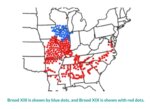Cicada BOOM
Historic event to result in millions of cicadas in Iowa’s forests
In a year that’s already been packed with natural phenomena, add one more to your list: The cicadas are coming to Iowa, and they’re coming in droves.
“Millions of these guys are going to come out, and they’re really loud,” explains Paul Mayes, who spent more than 30 years as a biologist at Muscatine Community College.
One of the defining features of a cicada is its singing, which can be as loud as 100 decibels, similar to that of a lawnmower, dirt bike or tractor.
“When they come out, all kinds of animals eat them, so they come out by the millions in order to survive,” explains Mayes. “They simply overwhelm all the predators.”
So, millions of cicadas singing in gratuitous harmony, that’s what we have to look forward to in Muscatine County early this summer.
When cicadas emerge from the ground, they only live four to six weeks—just long enough to climb a tree, eat, mate, lay eggs and start the cycle all over again.
But what makes 2024 extra special is the one-two punch of cicadas. You see, for the first time in 221 years, two different groups, or broods, will be emerging at the same time.
The larvae of the first brood, known as Brood XIII, live underground and feed off of roots for 17 years before emerging. Meanwhile, Brood XIX lives underground for 13 years before emerging.
Both of these broods will be emerging at the same time, meaning millions of “periodical” cicadas in Iowa, and trillions of periodical cicadas across the rest of the United States.
“It only happens every 221 years, so the last time this exact event happened Thomas Jefferson was president, and the Lewis and Clark expedition was underway,” explains Mayes.
The cicada life is a simple one; once they’re born, cicada nymphs fall from the tree branches and burrow underground. These nymphs are small, white and mushy little darlings.
They then spend most of their lives living underground, only to emerge after properly developing, waiting for the soil to reach approximately 64 degrees.
Once they emerge from the ground, they climb the nearest tree, have a bit to eat, mate, lay their eggs and fall to the ground dead. The eggs hatch and the cycle begins again.
But, because they are temperature-dependent, their emergences may vary. In 2024, they are expected sometime in May or early June.
“In Iowa, there’s a little bit of a land gap between the broods,” explains Mayes. “We will see the 17-year Cicadas all the way down to the top of the Louisa County Border.”
He says the 13-year brood will come up into the southern part of Louisa County; however, these facts are based off of data collected the last time these broods emerged.
So, while Muscatine County will mostly be inhabited by the 17-year brood, “It certainly isn’t out of the realm of possibility that the other brood could come pretty close to Muscatine County,” explains Mayes.
Andrew Forbes is the head of Forbes Lab at the University of Iowa, whose research has been featured in the New York Times, Science, The Independent (UK), New Scientist, Fox News, Smithsonian Magazine, The Atlantic and NPR's Weekend Edition.
Like Mayes, he also takes a keen interest in insects.
“Every 17 years these adult cicadas emerge from the ground, and they emerge all at once, sometimes almost a billion to an acre,” says Forbes.
“We’re going to get a big emergence in places where forests have not been historically cut down,” he explains. “Places that have had continuous forests in one spot for a long period.”
He states, like Forbes, that the 17-year cicadas will be found in Muscatine County, while the 13-year cicadas will most likely emerge in lower Louisa County.
But what does that mean for Iowa in general?
“For many years people called them locusts, which is a misnomer,” says Forbes. “Locusts are destructive grasshoppers, but cicadas don’t actually feed on crops.”
“They mostly direct their attention on trees,” he continues, “Studies show they actually improve the health of the forest overall because when they all die, all these nutrients go into the soil.”
So, farmers and food producers in the Midwest won’t really see any effect of the cicadas on their produce. Even small cities like West Liberty, Wilton and Durant may not see many.
However, Mayes admits that the millions of carcasses may give off a roadkill-like smell out on the country roads.
But, will city folk even be able to hear them?
“If you go to a forest where the emergence is happening, it’ll be very loud, and all the vertical surfaces will be covered (like trees),” says Forbes.
“I don’t actually expect that people in the cities will have to deal with any noise at all because most of the landscape, those natural forests, were turned into pastureland,” he says.
“As soon as those trees were killed, the cicadas died too,” he adds. However, he can’t say for certain one way or the other.
In fact, it’s hard to say if people in the city will be able to hear them; however, when thousands of fans jam into a sports arena and start screaming, they can be heard for miles.
The same may hold true for billions of cicadas; we’ll just have to wait and see.
“We’ll go from normal nighttime to daytime noises to all of a sudden, 24 hours a day, these cicadas buzzing,” says Paul Mayes, “But they mostly are in wooded areas.”
As previously mentioned, the 13-year cicadas, called Brood XIX, will emerge in Georgia and the southeast, while the 17-year cicadas, called Brood XIII, will appear in Iowa and Illinois.
Both of these broods are referred to as periodical cicadas because nearly all of the individuals in a local population develop synchronized and emerge in the same year.
The next time these two broods overlap won’t be for a couple of hundred years. Accordingly, the overlap of these two broods has been dubbed "cicada-geddon" by some scientists.
“This is not just a cicada year; it's a historic convergence of Broods XIII and XIX, making it a once-in-a-lifetime experience for enthusiasts and researchers alike,” says Dr. Gene Kritsky.
Kritsky is a Professor Emeritus of Biology and former Dean of the School of Behavioral and Natural Sciences at Mount St. Joseph University in Cincinnati, Ohio.
To help track the cicadas, Dr. Kritsky is reaching out to citizen scientists to download the Cicada Safari app, which allows anyone with a Smartphone to search, photograph, video, and help map cicadas.
"Cicada Safari has become an international phenomenon," Dr. Kritsky said. “It has been incredibly popular. And users can now help us track, photograph and map this historic event."
The Cicada Safari app can be downloaded from the Apple App Store or Google Play. You could say Dr. Kritsky is somewhat of a cicada fanatic.
He published “Tale of Two Broods: The 2024 Emergence of Periodical Cicada Broods XIII and XIX” in January 2024, which is available on Amazon right now.
That being said, he freely shares the following facts about cicadas online:
-Only male cicadas sing through sound-producing structures called tymbals on either side of the abdomen under the wings.
-Cicadas do not eat solid food but do drink fluids to avoid dehydration.
-Cicadas do not sting or bite and do not carry diseases.
-Periodical cicada years are quite beneficial to the ecology of the region. Their egg-laying in trees is a natural pruning that results in increased numbers of flowers and fruits in the succeeding years.
-Their emergence from the ground turns over large amounts of soil, and after they die, their decaying bodies contribute a massive amount of nutrients to the soil.
To learn more, visit www.cicadasafari.org. In the meantime, prepare yourself for another natural American phenomenon because a historic snowfall and solar eclipse just wasn’t enough.
To top that off, fluctuating temperatures in the central and eastern Pacific Ocean may cause an increase in violent storms and temperatures this summer.
So, enjoy the cicadas, Iowa, because they may be the least of our worries moving forward in 2024.
Comments




